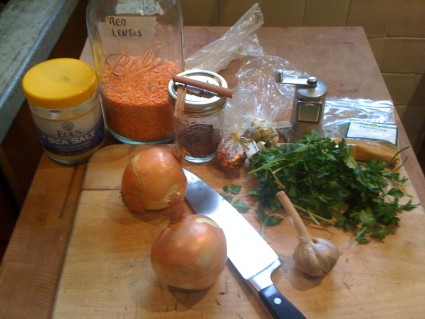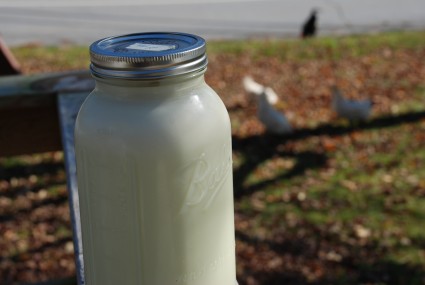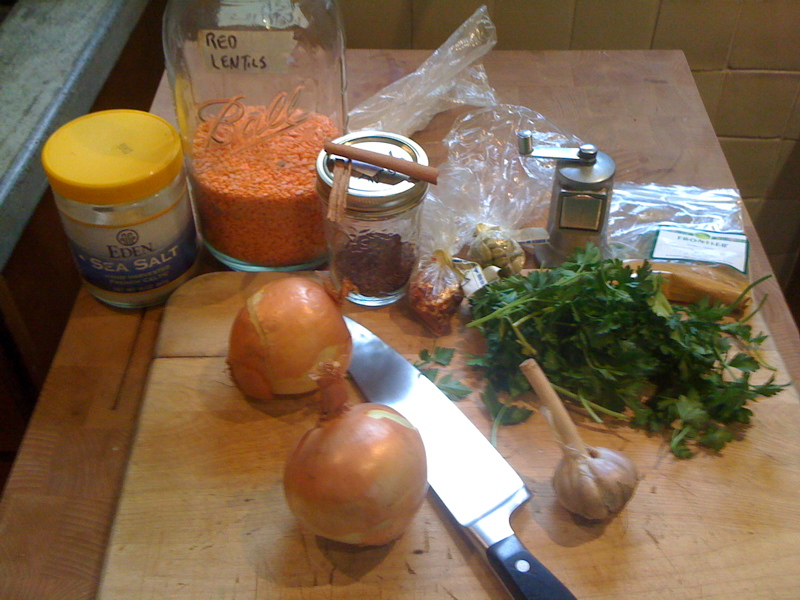In Tom’s Kitchen, Grist’s food editor discusses some of the quick-and-easy things he gets up to in, well, his kitchen. He thinks the column name sucks–please help him rename it. Email ideas to tphilpott[at]grist[dot]org. Forgive him for the lame iPhone photography.
———-
 Mise en place: getting it together in Tom’s kitchen. Photo: Tom PhilpottOn page 304 of Deborah Madison’s masterpiece Vegetarian Cooking for Everyone, there’s a recipe called, with undue modesty, “Red Lentil Dal with Aromatics.”
Mise en place: getting it together in Tom’s kitchen. Photo: Tom PhilpottOn page 304 of Deborah Madison’s masterpiece Vegetarian Cooking for Everyone, there’s a recipe called, with undue modesty, “Red Lentil Dal with Aromatics.”
The dish is gorgeous–and simple. You saute onion, garlic, and chile in ghee; add lentils, turmeric, and water, and cook until soft. You finish with shallots fried in ghee with mustard seeds and bay leaves, and finally some coconut milk. That’s it. The result gets depth and richness from the coconut milk and fried shallots; and this incredible, full curry flavor from the turmeric, mustards seeds, and bay. It’s a pure, elemental dish–perfect for warming up after a cold day outside.
The curry flavor in the dish surprised me. It really only has two spices associated with curry–mustard seeds and turmeric. I had always assumed to get a good, full curry flavor, you have to either grind a bunch of whole spices–cinnamon, cardamon seeds, cloves, etc.–or buy some pre-gound mix at the grocery store and hope for the best (because pre-ground spice mixes turn to sawdust with shocking speed). Deborah’s dish taught me that just a couple of well-chosen spices can deliver the goods.
Indeed, It wasn’t until I this recipe dish seven or eight years ago that I really got red lentils at all. They’re quick–they cook in little more than 30 minutes. And, goosed with curry spices and aromatics, they taste really, really good.
These days, I use Madison’s recipe only occasionally–when I have all the ingredients on hand (the absent ones typically being coconut milk and shallots, both of which I adore). When I don’t have them around, I do a kind of slapdash version, which I will describe now.
My hacked version relies on onions caramelized in butter (when I run out of onions, cooking becomes difficult) and whetever curry spices I have on hand. The onions, sweet and buttery, give the dish a savory depth that approaches, but doesn’t quite reach, the splendor of Madison’s. And the random nature of the curry spices I have on hand give the dish an unpredictability I treasure.
Mise en place.
• A good chunk of butter, about three tablespoons. (I’ve been using Organic Valley “pasture butter.”) Especially without the coconut milk, butter gives this dish richness. I don’t much like store-bought ghee, and am usually too pressed for time or lazy to make my own from butter. You could use good-quality vegetable oil in a pinch–or a combination of butter and oil. Homemade ghee is the gold standard.
• 2 small onions, halved lengthwise and sliced thinly.
• Curry spices. I really recommend keeping a store of black mustard seeds around. Other ones are turmeric, cinnamon, cardamon, and even store-bought “curry” mix. something hot is neccessary–crushed chile flakes, hot paprika, etc. Note: whole spices, like cinnamon stick and cardamon seed, add real vibrancy to the dish, and need not be ground. (See below.)
• 2-4 cloves garlic (I use four), chopped fine.
• A knuckle-sized knob of ginger, peeled and chopped fine, optional but recommended (note to self–why am I always out of ginger? I love the stuff.)
• I cup red lentils, rinsed and picked over for rocks, then drained.
• 3 cups water
• Good sea salt
• A loaded pepper grinder
• Something green–preferably cilantro, but parsley works, too–chopped.
Process:
In a medium-sized heavy-bottomed pot, heat butter over medium-low heat. When the butter has melted and its foam has subsided, add the sliced onion. Turn heat to a gentle medium. (Note: to aid the caramelizing process, i sometimes add a pinch of sugar.) Now add the spices–a little of this and a little of that. Definitely a full teaspoon of mustard seeds. If you have a small chunk of cinnamon stick, add it; two or three cardamon seeds would be good. You’ll fish them out later, or someone will accidently bite into one. I guarantee your the risk-reward ratio is favorable here. Sprinkle on a heavy pinch of turmeric, by all means, and “curry powder,” too; and whetever else you have in the way of curry spices. And good pinch of spicy paprika or crushed chile. Stir in spices. Cook, stirring often, until onions soften. Make sure they don’t scorch; turn down heat if they threaten to. When the onions are soft, turn heat to low and stir occasionally. Be patient. Soon enough, you will have lovely brown onions. When the onions have browned, stir in the garlic and, if you have it, the ginger. Let it cook another minute and add the lentils. Stir to coat with the curried brown onions. Add the water, bring to a boil over high heat, turn heat to lowest setting and cover. They’ll cook in 30-40 minutes. Check occasionally to make sure they’re not drying out; if so, add some hot water. Like split peas, they should be very soft–a kind of rough paste. When they’re done, taste, and add a half teaspoon of salt and a generous grinding of pepper. Then taste again. Note how the salt sparked everything to life. Correct for salt, and serve.
I serve them with brown rice, topped with chopped parsley. To take the dish to the next level, add some sauteed, curried collard greens to the side. All of that, plus a raw cabbage salad brightened with fresh lemon juice and chopped parsley, make a simple, delicious winter dinner.
This sort of food seems best-suited to beer–one with enough sweetness and roastiness to stand up to the spice. I enjoyed it recently with Duck-Rabbit Porter. I bet a zippy, dry Riesling would work, too.



